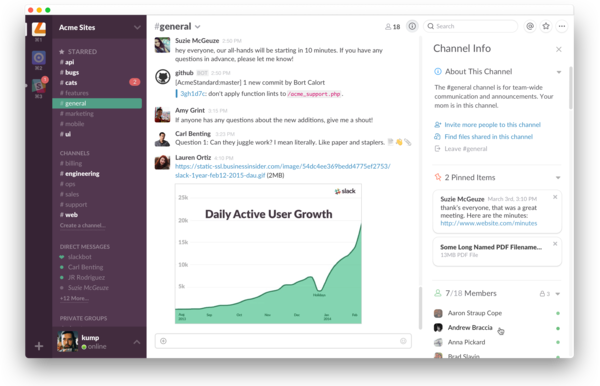How much of your day is devoted to e-mail? If you’re like most people, then probably a good chunk of time. According to a study from the Radicati Group, the average office worker sends and receives 121 e-mails a day—a figure that’s expected to rise to 140 by 2018. Yet the end of work e-mail might finally have arrived thanks to the startup Slack, which is changing the way co-workers communicate online.
So, what is Slack? Co-founded by Stewart Butterfield, the entrepreneur who sold his other startup, Flickr, to Google for a reported $25 million in 2004, Slack takes elements of e-mail, instant messaging, texting, and cloud storage and creates a new kind of communication tool.
At its core, it addresses many of the gripes people routinely have with work e-mail. Who wants to be Cc’d on an e-mail chain that has little if anything to do with your job? What about all the one-off e-mails you get in a day? Or how about searching through your crowded inbox for an attachment someone sent you months ago?

Most office workers would agree these are more than mere annoyances—they’re also productivity killers. Yet Slack fixes these and more e-mail-related problems, making it simple to communicate with your co-workers, regardless of location or time.
Once an organization has signed up for Slack—the company has a number of plans, including a free version and more expensive offerings that offer various features and tools—it can then create its own subcategories, known as channels. Channels help users to better organize their conversations around a specific team, project, or topic, whether it’s HR, upcoming happy hours, or a new business opportunity.
 Users can then be added accordingly to these channels, where their conversations are stored and catalogued. Individual members also have the option to target messages to all members of a channel or flag specific members using the @ symbol. Channel users can also upload documents and other attachments directly to Slack, and add specific comments to each, making it easy to later search for a particular file.
Users can then be added accordingly to these channels, where their conversations are stored and catalogued. Individual members also have the option to target messages to all members of a channel or flag specific members using the @ symbol. Channel users can also upload documents and other attachments directly to Slack, and add specific comments to each, making it easy to later search for a particular file.
There are, of course, times when you’d rather not broadcast a message to all of your co-workers. For those kinds of sensitive or confidential messages, Slack offers a direct messaging feature. Users also have the ability to create private groups for sensitive materials or projects you want kept under wraps. Unlike public channels, private groups can neither be joined nor accessed by non-members.

What’s arguably Slack’s greatest value-add is that it enables organizations to have a comprehensive communications center that consolidates the disparate management and internal communications tools that businesses often rely on. Slack can also be accessed from the web, as well as on iOs and Android devices, making for a more fluid system of communication.
Given its ease-of-use and intuitive interface, Slack has caught on very quickly, earning a $2.8 billion valuation earlier this year, according to CNBC. It now counts a diverse array of organizations as clients, including NASA’s Jet Propulsion Laboratory, Spotify, the New York Times, eBay, Yelp, and NBCUniversal, among others.

This article was syndicated from Business 2 Community: Thanks to Slack, the End Of Work E-Mail Is (Finally!) Here
More Sales & Marketing articles from Business 2 Community:




